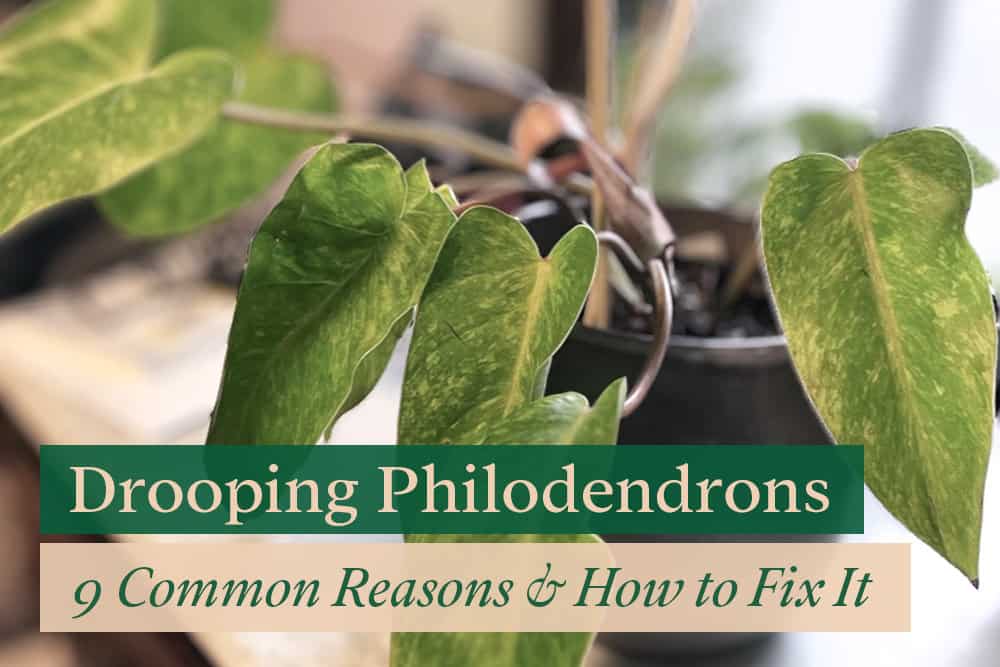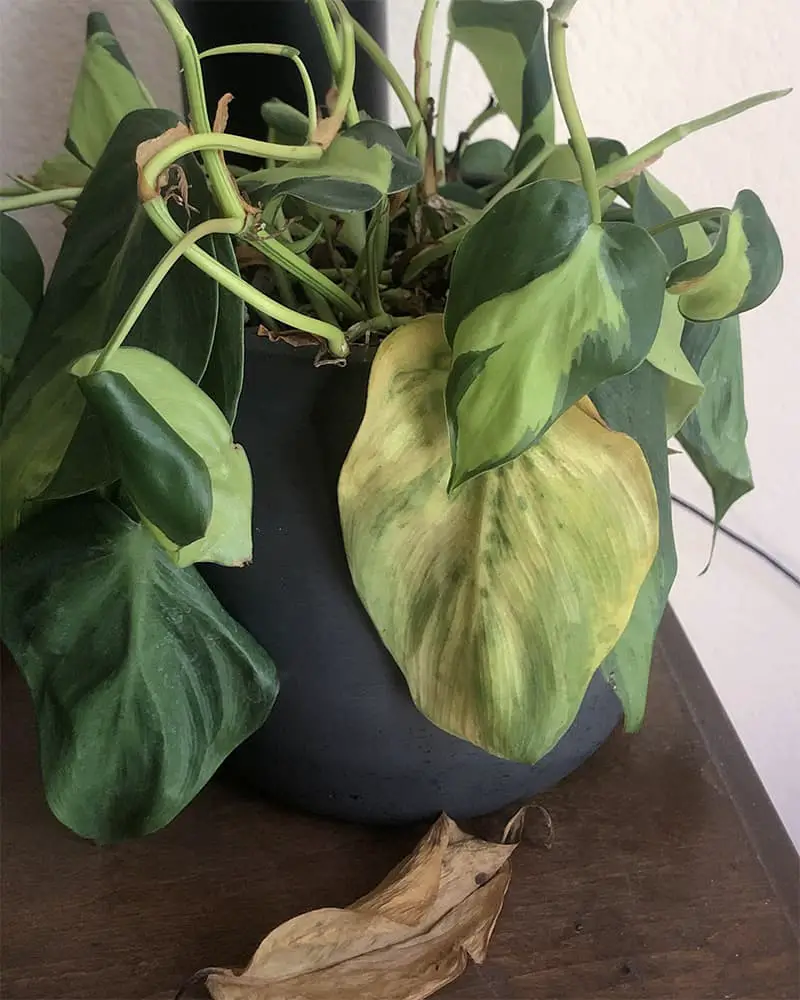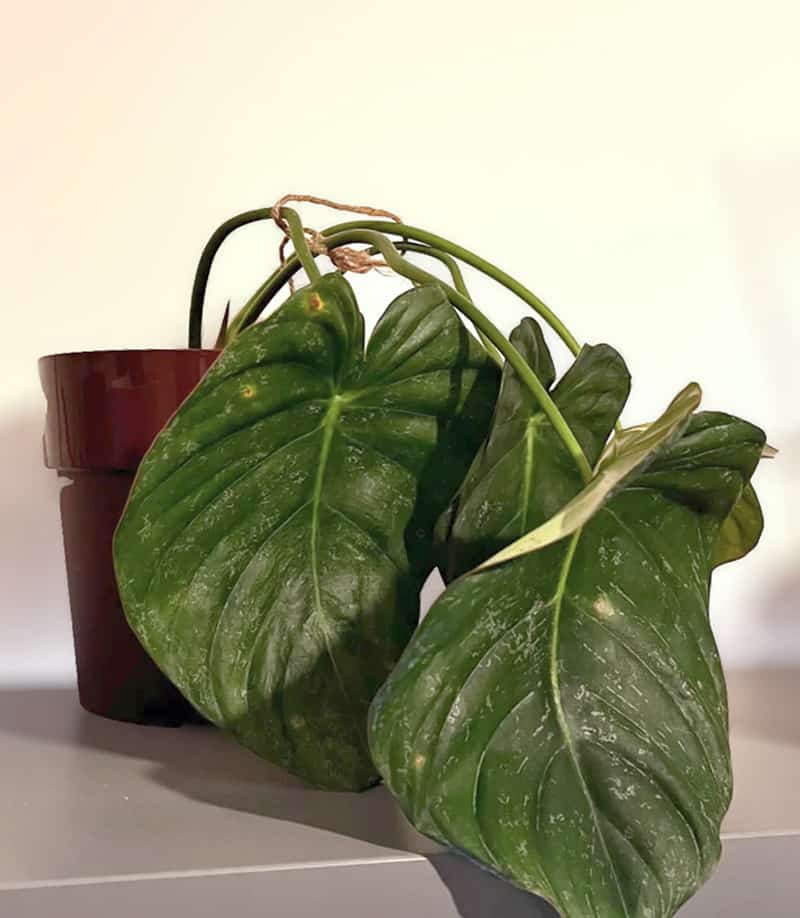
Philodendrons are easy plants to maintain, but they can sometimes droop or wilt.
Philodendrons droop or wilt due to loss of cell turgidity. Healthy Philodendron plant cells have plenty of turgor pressure, a force that pushes the cell’s fluid contents against its wall, giving the plant a firm and upright appearance. Cell turgidity loss is also called flaccidity.
Dehydration is the most common cause of flaccidity, but there are many other causes, which we’ll discuss in detail below.
Can You Revive a Drooping Philodendron?
If your beloved Philodendron plant is drooping, you’re probably wondering if you can revive it.
You can revive a drooping Philodendron, but it depends on how long the plant has lacked cell turgidity. The faster you take action, the greater the chances of reviving the Philodendron. Your revival method will also depend on the cause of the wilting.
Thankfully, the most common causes of Philodendron leaves drooping are easy to resolve as long as the plant has not died.
How Long Does It Take To Revive the Drooping Plant?
If your Philodendron’s leaves are drooping, it’s not usually an immediate fix.
It can take between one and five days to revive the drooping plant, depending on the cause of the wilting. The cause of the drooping also affects how often you need to attend to the plant and the intensity of the treatment method.
Possible Reasons for Drooping Philodendrons
We’ve discussed what happens in a Philodendron’s cells when it’s drooping but what causes this?
Drooping Philodendrons are commonly caused by under-watering, over-watering, over-fertilizing, improper temperature and humidity conditions. However, other factors such as transplant shock, pest infestation and fungal diseases can also contribute to wilting.
We’ll discuss the signs of each of these causes below and offer some valuable fixes:
1. Under-watering
Underwatering is a significant cause of a Philodendron’s leaves drooping. As the Philodendron plant loses water, its cells gradually shrink as the cell walls draw inward and lose turgor pressure.
Underwatering is easy to detect and resolve, as long as you’ve noticed it early enough.
Signs of Underwatering

If your Philodendron plant is dehydrated, here are the most common signs:
- The soil is completely dehydrated
- Curled leaf and stem tips
- Growth stops or slows down significantly
- Brown leaf edges (in extreme cases, the leaves will be completely brown)
How To Fix Underwatering
As long as your Philodendron hasn’t been dehydrated for an extended period and is not dead, you can quickly remedy the situation.
Firstly, you want to make sure your Philodendron is not in direct sunlight. Moving it to a partially shady area will prevent soil and the plant from losing excessive amounts of water.
Once it has been placed in an optimal environment, you can water a dehydrated Philodendron as usual.
However, take care not to overwater it to compensate for the dehydration, which could put the plant under more stress.
Philodendrons should be watered every one to two weeks. However, if you notice the top half of the soil is completely dry after five days, it’s time to water it again as the plant has used up the water.
Your Philodendron should recover in two weeks if dehydration is the only cause of its drooping.
2. Over-watering
Philodendrons thrive in soil with light but consistent moisture, and they like to soak up water in the soil gradually.
Constantly oversaturating the soil can overwhelm the roots with water, preventing the Philodendron from photosynthesizing and obtaining sufficient nutrients. Saturated cells can eventually burst, causing the plant to droop.
In extreme cases of overwatering, Philodendrons can develop root rot, which prevents the roots from absorbing oxygen and soil nutrients effectively.
Signs of Overwatering

Symptoms of overwatering your Philodendron include:
- Mold, algae, or fungus in the soil, stems, or leaves
- Discolored leaves (generally yellow or light green)
- Wilted leaves and stems
- Brown spots on the leaves and stem
- Soil has a rotten odor
- Roots are brown and mushy
- Slow growth rate
How To Fix Overwatering
The first step in treating an overwatered Philodendron is to stop watering it.
If possible, place the pot in bright, indirect sunlight so that the soil can evaporate the excess water faster.
If the soil is still mostly wet after a few days, your soil might be too dense and poorly draining. Transplanting your Philodendron into fresh soil that drains well might be a good idea.
While transplanting your Philodendron, you should check its roots.
Root rot is common in overwatered plants as the continuously wet and dark soil promotes bacterial and fungal build-up around the roots.
As long as the root rot is not too advanced, you can save your Philodendron by cutting away the infected black mushy roots and replanting it into fresh dry soil.
Before doing this, allow the roots to dry out by removing the plant from the soil, gently scraping away the wet soil, and placing it in a low-humidity location for a few hours.
After transplanting your Philodendron into new, dry soil, wait for about five days before resuming your regular watering schedule.
3. Low Humidity
Drooping Philodendrons can also be caused by low humidity.
In a room with low humidity, the plant loses moisture to the air faster by transpiration. An extended period of low humidity will dehydrate the plant and cause it to lose cell turgidity, which in turn causes it to droop.
Even though there are many reasons for low humidity, it usually occurs in colder regions, especially during winter. During colder months, the air couldn’t hold as much water vapor.
Signs of Low Humidity in Philodendron
The easiest way to determine whether your Philodendron is suffering from low humidity is to place a hygrometer in the room.
Generally, Philodendrons thrive in locations where the humidity is between 65% and 80%, and they can withstand places where the humidity is as low as 55%.
However, when humidity levels are below 55%, Philodendrons will show signs of distress, such as the following:
- Droopy leaves and stems
- Shriveling or curling leaves.
- Browning or crisping leaves.
- Leaf scorch.
- Wilting leaves and stems
How To Fix Low Humidity
If you wish to increase the humidity of your Philodendron, there are a few options that you can choose from, such as placing pebble trays or misting.
However, from my experience, those solutions only provide a temporary increase in humidity that will not last more than a few minutes.
The best way to increase the humidity of a room is to install a plant humidifier that you can control remotely through your mobile device.
Additionally, this humidifier can be set to turn on automatically when the humidity falls below a certain level.
4. Excessive Heat
If your Philodendron doesn’t live in a temperature-controlled environment, it can experience heat stress during the summer or winter when the heating is turned up.
Also, transpiration occurs at a faster rate at higher room temperatures. Despite adequate moisture in the soil, if the roots are unable to replace water loss quick enough, your Philodendron will droop in heat.
Signs of Heat Stress
Here’s how to tell if your Philodendron is experiencing heat stress:
- Curling leaves with dry or brown edges.
- Drooping leaves and stems
- Shedding leaves
- Sunscald leaves
- The soil feels hot.
How To Fix Heat Stress
If you believe your Philodendron is experiencing heat stress, it’s essential to act quickly to save the plant.
You should immediately remove it from the hot area and place it in a cool and shady spot. Philodendron plants should be kept in warm, humid conditions, with optimal temperature between 60°F and 80°F (15°C and 26°C).
Additionally, a humidifier can be used to maintain optimal humidity around the plants, which will control the rate of transpiration. If the soil is completely dehydrated, it needs to be watered immediately.
Consider adding more mulch to the top soil if it feels hot so that the plant can recover from heat stress more quickly.
5. Coldness and Draft
On the other hand, extreme cold weather and draft can also cause your Philodendron to droop.
When temperatures drop below 50°F (10°C), the cells freeze, causing damage and interrupting the flow of nutrients and water.
In addition, as damage to the cell becomes substantial, the cell walls collapse and lose turgor pressure. As a result, the plant begins to droop.
Signs of Cold Stress
Philodendron plants suffering from cold stress usually show the following signs:
- Stunted growth
- Wilting leaves and stems
- Discolored leaves
- Black patches on leaves and stems
- Loosened root system
How To Fix Cold Stress
Moving your Philodendron out of the cold environment is the first step in treating cold stress.
Take care not to overcompensate by moving the plant to a hot place as it needs time to acclimatize to the warmer temperature.
Next, water your plant and let the water drain out of the pothole. It is important that the plant receives enough water to replace the moisture that has been sucked from the leaf tissue.
You should avoid pruning or fertilizing your Philodendron for at least one week while it is recovering.
Lastly, Philodendrons can also benefit from grow lights during the winter months to accelerate their recovery.
6. Over-Fertilizing
With Philodendrons, too much of a good thing can be harmful, especially when it comes to fertilizer.
Overfertilization can burn the Philodendron, weaken it, and make the soil too salty. This can result in dehydration and the inability to absorb nutrients from the soil.
In the absence of enough water and nutrients, the cell walls begin to collapse, causing the Philodendron to droop.
Signs of Over-Fertilizing
The following signs often indicate that your Philodendrons have been fertilized too much:
- The leaves have yellow, brown, or curled edges.
- You notice a fertilizer crust on the soil.
- It has drooping stems and leaves.
- The growth rate is slow or non-existent.
- The roots are black.
- It’s prone to diseases or pests.
How To Fix Over-Fertilizing
Fixing overfertilization in other plants is easy as you can water the soil thoroughly a few times to leach out the excess fertilizer.
Make sure all salt buildup is removed by repeating the process three to four times as necessary.
The roots of the plant should be checked if the damage is extensive. Remove any dead black roots, leaving only white ones.
The next step is to transplant your Philodendron into the fresh soil.
Your Philodendron should recover in less than a month if you take the above steps immediately. During this period, do not fertilize the plant.
7. Transplant Shock
Did you just repot your Philodendron recently? In that case, transplant shock might be the cause of your drooping Philodendron.
Recently-transplanted Philodendrons can suffer from stress, primarily if they were handled roughly and incorrectly.
Signs of Transplant Shock

Here are obvious signs of transplant shock in Philodendrons:
- Yellow or brown leaves
- Wilting stems
- Rapid leaf loss
How To Fix Transplant Shock
If your Philodendron gets transplant shock, you can only keep giving it care and wait for it to heal.
You can reduce the risk of transplant shock by keeping the living conditions unchanged during repotting so that it does not require too much adjustment. These include temperature, humidity and lighting conditions.
As a side note, reducing the number of leaves on the plant can help the plant recover faster, as the energy produced can be shared between fewer leaves. You can start by pruning dead or older leaves.
8. Pests Infestation
All plants are vulnerable to pests, but mealybugs, scales, aphids, and spider mites often target Philodendrons.
These pests can populate quickly and sucking on the plant’s sap and absorb all nutrients from it.
You should identify the type of pest infesting your plant as soon as possible, so that you can take action before the damage becomes extensive.
Signs of Pest Infestation

The following are common signs of pest infestation in Philodendrons:
- Distorted or discolored leaves
- Webbing underneath leaves
- Tiny pests visible on the leaves
- Sticky substance or brown spots on leaves
How To Get Rid of Pest Infestation
The leaves are the most commonly affected sections on a Philodendron with a pest infestation.
Gently removing badly-infested leaves is the first step in treating the infestation.
If the infestation is not severe, you can start with showering the plants under running water to get rid most of the pests on the leaves and stems. Make sure, however, that the water drains out completely to avoid overwatering.
Products such as insecticidal soap, Hydrogen peroxide, insecticide, disinfectant alcohol, or neem oil can be used to treat the infestation.
You can apply them with a cotton pad or spray them on the infected area. The process should be repeated every three days until all the pests have been removed.
9. Fungal Diseases
Like all plants, Philodendrons are susceptible to various fungal diseases. Common fungal diseases in Philodendrons include:
- Southern blight
- Anthracnose
- Pythium root rot
- Phytophthora leaf spot
- Dactylaria leaf spot
Signs of Fungal Diseases
Your Philodendron might have one of the above fungal diseases if it exhibits any of the following signs:
- Irregular-shaped dark brown lesions that seem water-logged.
- 1/8 inch-wide (0.31 cm) lesions with yellowish-green margins.
- Yellowing leaf margins that finally die, turning brown.
- Yellow leaves that turn brown while remaining attached to the stem.
- Wilting or discolored leaves with dark or translucent spots.
- What appears like stem or root rot, but the infection eventually forms cotton-like masses around the infected areas.
How To Treat Fungal Diseases
Fungal diseases in plants are typically difficult to treat. Besides, most of the available fungicides are not environmentally-friendly hence it’s best to use prevention measures instead.
Here are some common ways to treat fungal diseases in Philodendron:
- Ensure to plant your Philodendron in sterile soil that has good drainage.
- Eliminate any weeds and dead leaves around the plants to reduce the spread of fungal diseases.
- Steer away from overhead irrigation or watering.
- Get rid of severely infected Philodendron plants.
- When growing your Philodendron outdoors, use raised benches – helps prevent phytophthora leaf spot.

